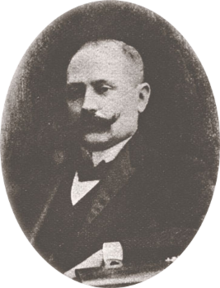Pavel Ignatiev
| Paul Ignatieff | |
|---|---|
 |
|
| 24th Education Minister of the Russian Empire | |
|
In office January 9, 1915 – December 27, 1916 |
|
| Preceded by | Lev Kasso |
| Succeeded by | Nikolai Kulchitsky |
| Personal details | |
| Born |
Pavel Nikolayevich Ignatiev Павел Николаевич Игнатьев July 12 [O.S. June 30] 1870 Constantinople, Ottoman Empire |
| Died | August 12, 1945 (aged 75) Upper Melbourne, Quebec, Canada |
| Nationality | Russian |
| Spouse(s) | Natalia Nikolayevna Meshcherskaya |
Count Pavel Nikolayevich Ignatiev (Russian: Павел Николаевич Игнатьев, sometimes rendered in English as Paul Ignatieff; June 30/July 12, 1870 Istanbul– August 12, 1945) was an Imperial Russian politician who served as Education Minister for Tsar Nicholas II. He was the son of Count Nikolay Pavlovich Ignatyev, Minister of the Interior for Tsar Alexander III. After the October Revolution brought the Bolsheviks into power, Pavel Ignatieff fled Russia with his family, ultimately ending up in Canada.
Ignatieff's father, Count Nikolay Pavlovich Ignatyev, was Russian Minister of the Interior under Tsar Alexander III. Paul Ignatieff married Princess Natalya Meshcherskaya (1877-1944) in Nice, France on April 16, 1903. They would have seven children, all boys, two of whom died as infants.
He was a graduate of the University of Kiev. Afterward he entered the Imperial Ministry of Agriculture eventually becoming a Director of one of its departments in 1909. He was appointed Assistant Minister of Agriculture in 1912. In 1915, during the First World War he was appointed Minister of Education. He held that position until December 1916.
During October Revolution, Ignatieff was captured and was to be executed. However, he was spared because the Polish commissar overseeing his execution said that he was a good man because he had implemented progressive policies such Polish language rights while Education Minister. Ignatieff and his family then fled to England in 1919 and lived on a farm in Sussex, before moving to Canada.
In 1925, the family emigrated to Canada, and settled permanently three years later in Upper Melbourne in Quebec, where he died August 12, 1945.
...
Wikipedia
